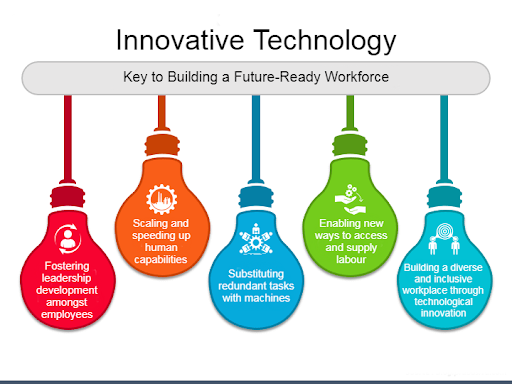The world is rapidly changing, and so is the way we work. Automation, advancements in artificial intelligence, and work culture evolution are swiftly changing the status quo. With employees and organizations undergoing transformation and disruption, most innovative leaders of 2023 now face the prospect of stepping up their efforts to prepare their workforce for the future and to keep up with the times.
This is where innovative technology and transformational leadership come in. By leveraging technology to reskill, augment the workforce, and understand what drives the new age of work, business leaders can position themselves to succeed in the new digital world.
Forums such as the upcoming B20 Summit 2023 in India are the perfect platforms to address critical issues in preparing an empowered, modern workforce. They highlight how skilling and augmenting the workforce with technology are key to creating a sustainable workforce for the future. Doing so can also unlock a developed economy with greater purchasing power for citizens, better productivity, accelerated innovation, and more.
Let us deep dive into this critical topic and unearth key insights for anyone aiming to become an innovative entrepreneur with a future-ready workforce.
The Tectonic Shift in Talent
How are talent and workforces undergoing a tectonic shift?
This is a question that most innovative leaders of 2023 and organizations are asking themselves in the face of rapid changes in technology, demographics, and culture. The answer is that talent and workforces are becoming more diverse, agile, and adaptable. They also face new challenges and opportunities that require new skills, mindsets, and behaviors.
Some of the factors driving this tectonic shift include:
- The rise of remote and hybrid work models enables workers to collaborate across time zones, geographies, and cultures
- The emergence of new forms of learning and development that leverage digital platforms, gamification, and peer-to-peer feedback
- The increasing demand for creativity, innovation, and problem-solving skills that can address complex and uncertain situations
- The growing importance of social and emotional intelligence that can foster trust, empathy, and resilience among teams and stakeholders
- The need for diversity, equity, and inclusion that can harness the power of different perspectives, backgrounds, and identities
These factors create new opportunities for talent and the workforce to thrive in the 21st century. They also challenge every innovative entrepreneur and organization to rethink how they attract, retain, develop, and engage their people. Leaders and organizations need to embrace a culture of learning, experimentation, collaboration, and inclusion to succeed in this tectonic shift. They also need to leverage data-driven insights to understand their talent needs, gaps, and potential.
By doing so, they can create a workforce ready for the future and aligned with their vision and values.
How Technology Can Help
Technological innovation is affecting the future of work in five key ways:
- Fostering leadership development amongst employees: Technology can help by providing online courses and certifications, enabling access to world-class learning resources and platforms, creating immersive reality environments for collaboration and problem-solving, or automating administrative tasks to enhance strategic focus. For example, Bajaj Finance Limited – the NBFC arm of Bajaj Finserv led by Chairman and Managing Director Sanjiv Bajaj – has a learning and development platform called ILLUME that offers online courses and gamified learning experiences to its employees on various topics related to leadership, such as innovation, collaboration, communication, problem-solving, etc.
- Scaling and speeding up human capabilities: Technology can augment human skills and intelligence, enabling workers to perform tasks faster, better, and more efficiently. For example, cloud computing, data analytics, and collaboration tools can enhance productivity, innovation, and creativity. TCS, the IT arm of the Tata Group led by iconic, innovative entrepreneur Ratan Tata, has an internal talent marketplace called Talent Cloud that allows employees to work on projects across different domains and geographies based on their skills and interests. Technology can also enable workers to learn new skills and access opportunities through online platforms, courses, and certifications.
- Substituting redundant tasks with machines: Technological innovation in business can also replace human tasks that are routine, repetitive, or dangerous. For example, robotics, automation, and artificial intelligence can perform physical or cognitive tasks that humans previously did. This can free workers to focus on more value-added activities requiring human judgment, empathy, or creativity.
- Enabling new ways to access and supply labor: Technology can also create new work arrangements that transcend traditional time, space, and organization boundaries. For example, remote work, gig work, crowdsourcing, and freelancing can offer more flexibility, autonomy, and choice to both workers and employers.
- Building a diverse and inclusive workplace through technological innovation: Technology can help analyze the language and tone of job postings and suggest ways to make them more inclusive and attractive to a wider pool of talent. It can also help minimize the influence of human biases in hiring and performance management processes by using artificial intelligence (AI) to analyze candidates objectively instead of focusing on demographics. For example, Accenture commits to achieving a gender-balanced workforce by 2025. It also has various programs and platforms to promote diversity and inclusion among its employees, such as Tech4Good, which leverages technology to create social impact.
Final Thoughts: What Most Innovative Leaders of 2023 and Beyond Can Do to Transform Their Workforce
So, what can businesses do to maintain a competitive advantage in the future of work? Here are some suggestions:
- Embrace technology as an enabler of innovation, productivity, and collaboration
- Invest in human capital as a source of differentiation and value creation
- Develop a diverse and inclusive workforce
- Build a distributed network of employees
- Foster a culture of learning and agility
Many reports paint a fascinating picture of where the future of the workforce is headed. According to PwC’s Workforce of the Future report, there are four possible scenarios for the future of work in 2030, depending on how people and organizations respond to megatrends. They are:
– The Red World: Where digital platforms enable those with winning ideas and specialist skills to flourish.
– The Blue World: Where large corporations grow so big and influential that they become more powerful than national economies.
– The Green World: Where corporate responsibility is not just a nice-to-have, but a business imperative.
– The Yellow World: Where social enterprises and cooperatives thrive, as people prioritise human connection and collaboration over competition.
Each of these scenarios has its own implications for businesses and workers in terms of skills, culture, structure, rewards, and risks. No one can predict which scenario will prevail or how they will interact. However, we can use them as tools to explore different possibilities and prepare for different outcomes.
The key for leaders and organizations is to ensure that technological innovation adds to rather than detracts from their workforces’ abilities. They also need to step up efforts to upgrade their work culture toward being more diverse, distributed, and dynamic.
Also check – Writing an Economic Dissertation on the Work of President Biden? Ask Expert




June 9, 2023
[…] the Indian NBFC landscape. Under his leadership, Yes Bank rapidly expanded its operations, offering innovative banking solutions and financing options to individuals and businesses. Kapoor’s astute business acumen and […]
December 19, 2023
[…] Also check – Innovative Technology: Key to Building a Future-Ready Workforce […]